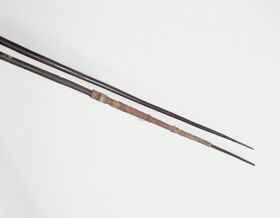Spears
Place: Unknown
Category: Fishing & hunting
wood, unattributed, l. 213 cm; l. 259.5 cm, Inv. Oz 1287, 1288
Humphrey No. 333: ‘another [Lance] carved, and bound near the point with Bark Cloth, from the Marquesas.’ (= Oz 1287)
Forster Register A. 17 (?): ‘3 long staffs from the island of Tanna’ (= Oz 1288)
Both objects have the same provenance, because of their form, material, and especially the engraved patterns at the beginning of the foremost quarter of the spear. They consist of wooden sticks which are relatively thin at the lower end and become gradually thicker, attaining a maximum thickness immediately before the engraved patterns. From there, they become gradually thinner again, and end in a point. The patterns consist of two bands at intervals of 5 to 8 cm. They consist below and above respectively of a closed band of circular engravings encircling the shaft, and framing line engravings running parallel to the head, also laid out in bands. Oz 1287 has thick bark bast wrappings immediately next to the upper engraved pattern. The function of these is unclear. There are no comparable spears in the literature; the examples depicted by von den Steinen are spears with barbed points. For these reasons, a definite geographical attribution to the Marquesas is not possible (on the Marquesas spears cf. Handy 1923: 130f, Fig. 12c, and Linton 1923: 390f, as well as the illustrations by von den Steinen 1928b: dQ No. 3).
The object with the Inv. No. Oz 1288 features the ‘F’ label of the Forster Collection; the resulting problems for an identification are explained for the above entry. Insa Wendt
Sources
Handy, ES Craighill, The Native Culture of the Marquesas, Bernice P Bishop Museum Bulletin, vol. 9, Honolulu, 1923.
Linton, Ralph, The Material Culture of the Marquesas Islands, Memoirs of the Bernice P Bishop Museum, Honolulu, 1923, vol. 8, no. 5.
Steinen, Karl von den, Die Marquesaner und ihre Kunst. Primitive Südseeornamentik III: Plastik, Berlin, 1928b.

